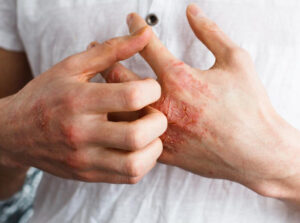At Pariser Dermatology Specialists, our board-certified dermatologists treat eczema (atopic dermatitis) at all seven of our convenient office locations in Virginia Beach, Chesapeake, Norfolk, Newport News, Suffolk, and Williamsburg.
Eczema affects patients of all ages — and it’s one of the most common conditions we see every day. Our team provides personalized, long-term care to help control flare-ups, soothe irritation, and protect your skin’s health.

What Is Eczema (Atopic Dermatitis)?
Eczema, also called atopic dermatitis (AD), is a chronic inflammatory skin condition that often begins in infancy or early childhood. Common characteristics include:
- Dry, scaly, or itchy patches
- Redness or inflammation
- Commonly affects the cheeks, scalp, forehead, or body
- Intense itching that can lead to scratching and secondary infection
Because eczema tends to come and go, early and consistent management is key to keeping symptoms under control.
Common Signs and Symptoms
Watch for these eczema symptoms:
- Persistent itching (often worse at night)
- Dry, rough, or thickened skin
- Red or inflamed patches
- Cracking, oozing, or crusting
- Flare-ups triggered by stress, heat, allergens, or certain products
If you live in the Hampton Roads area and notice these signs, our dermatologists can help you find relief.
📞 Call (757) 622-6315 or book an appointment online to get started.
How We Diagnose Eczema
At Pariser Dermatology, we take a comprehensive approach to accurately diagnose and treat eczema:
- Skin Examination – We evaluate affected areas and identify common eczema patterns.
- Medical & Family History – We discuss your symptoms, triggers, and any history of allergies, asthma, or eczema.
With multiple Hampton Roads dermatology locations, expert care is always close to home.
Eczema Treatment & Management Options
There’s no one-size-fits-all solution for eczema. Our dermatologists design a custom treatment plan to:
- Reduce inflammation and itching
- Strengthen and restore the skin barrier
- Prevent and control flare-ups
- Minimize scarring and infection risk
Treatment options may include:
- Prescription topical medications (creams, ointments, or steroids)
- Regular moisturizing and skin barrier repair
- Oral or systemic treatments for moderate to severe eczema
- Guidance on triggers, such as fabrics, soaps, allergens, and temperature
- Ongoing care and monitoring to adjust your treatment plan as needed
What to Expect Long Term
- Many children outgrow eczema as their skin matures
- Adults may experience recurring but manageable symptoms
- Consistent treatment helps reduce flare frequency and intensity
- Early intervention leads to better long-term results
At Pariser Dermatology, we focus not only on treating eczema symptoms but also on protecting your skin for life.
Why Choose Pariser Dermatology Specialists?
- Experienced, board-certified dermatologists specializing in eczema and skin care
- Seven convenient Hampton Roads locations: Chesapeake, Newport News, Norfolk, Suffolk, Virginia Beach, and Williamsburg
- Personalized, patient-centered approach — we listen, explain, and adjust your treatment as needed
- Trusted local care — serving the Hampton Roads community since 1946
- Easy scheduling — call or book online
Ready to Find Relief from Eczema?
Don’t let itching, irritation, or discomfort take over your life.
Call Pariser Dermatology Specialists today at (757) 622-6315 or schedule your appointment online to meet with an eczema specialist near you.
Your skin deserves expert care — and we’re here to help you feel better every day.
Outcome
Studies have found that when atopic dermatitis develops in an infant or young child, the child tends to get better with time. For some children, the condition completely disappears by age 2. About half (50%) of the children who get eczema will have it as an adult. The good news is that it often becomes milder with age. There is no way to know whether the AD will go away or be a lifelong disease. This makes treatment very important. Treatment can stop the eczema from getting worse and also helps to relieve the discomfort.



